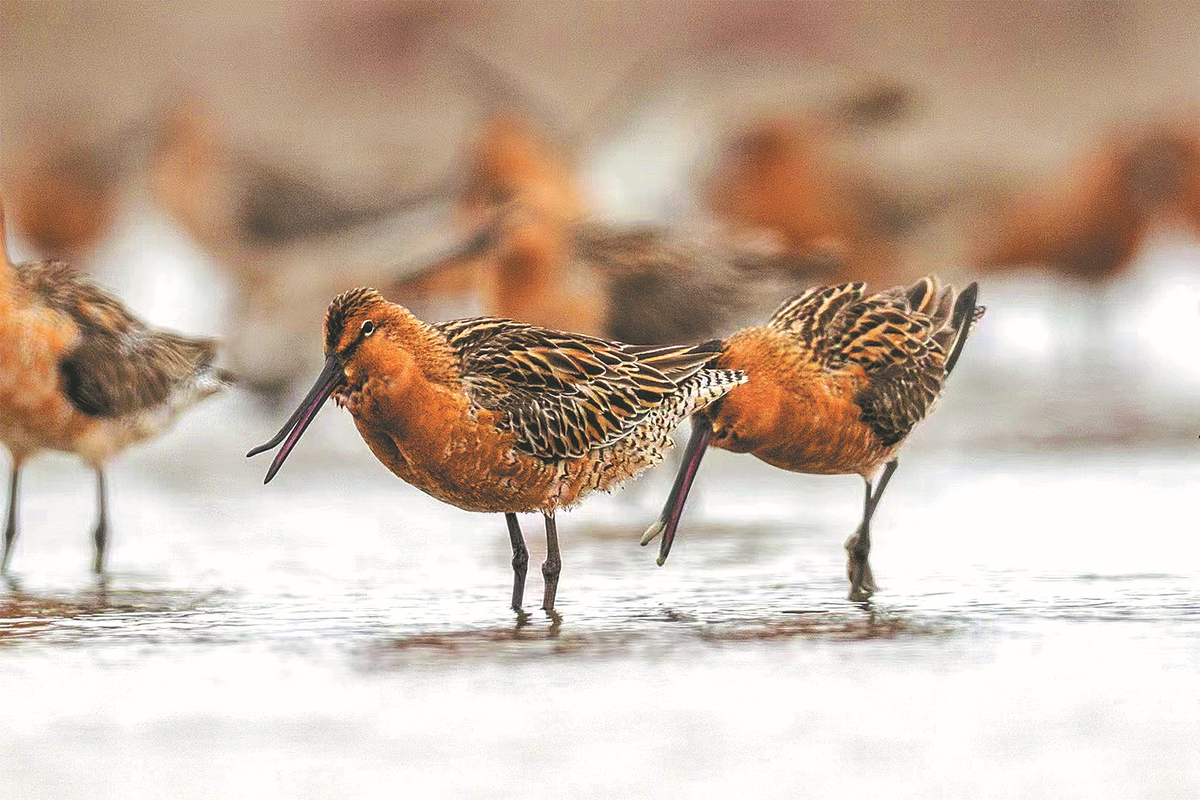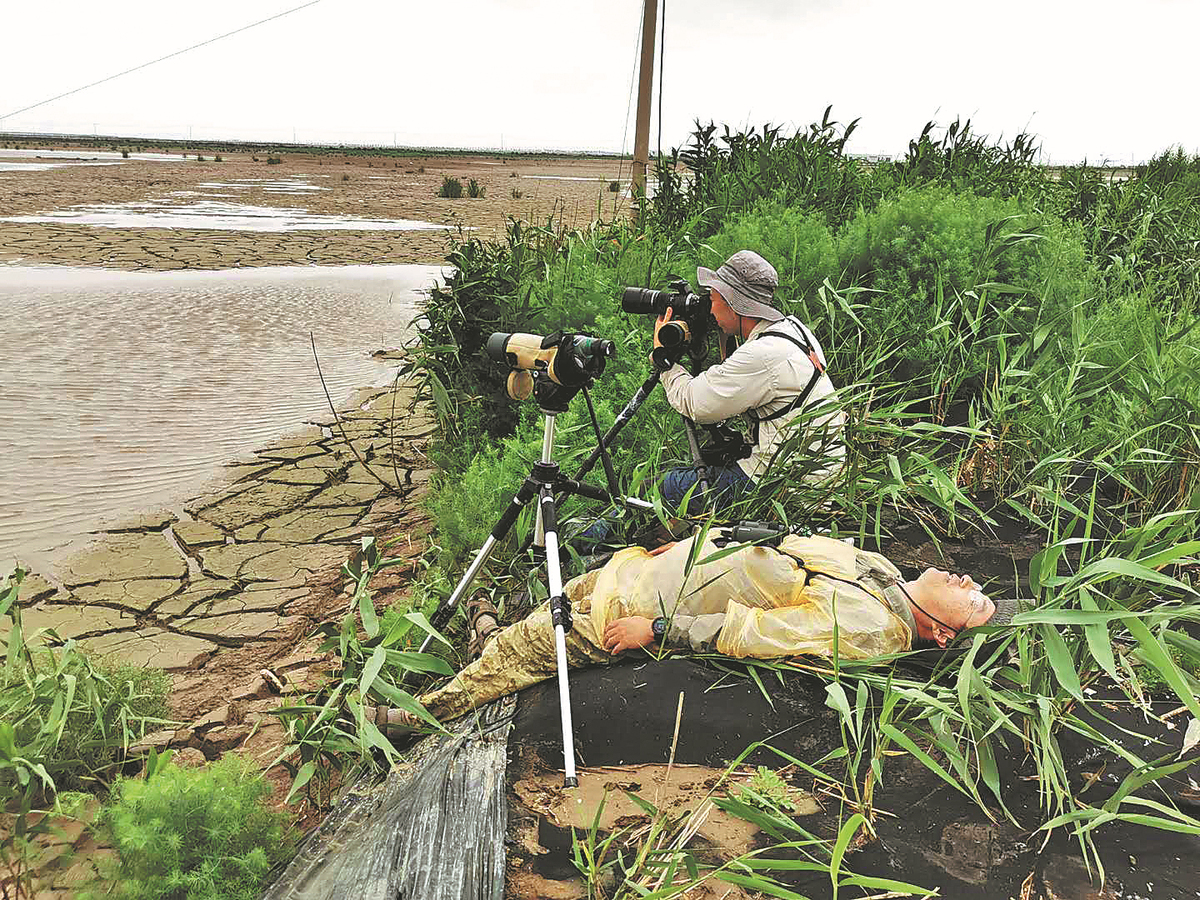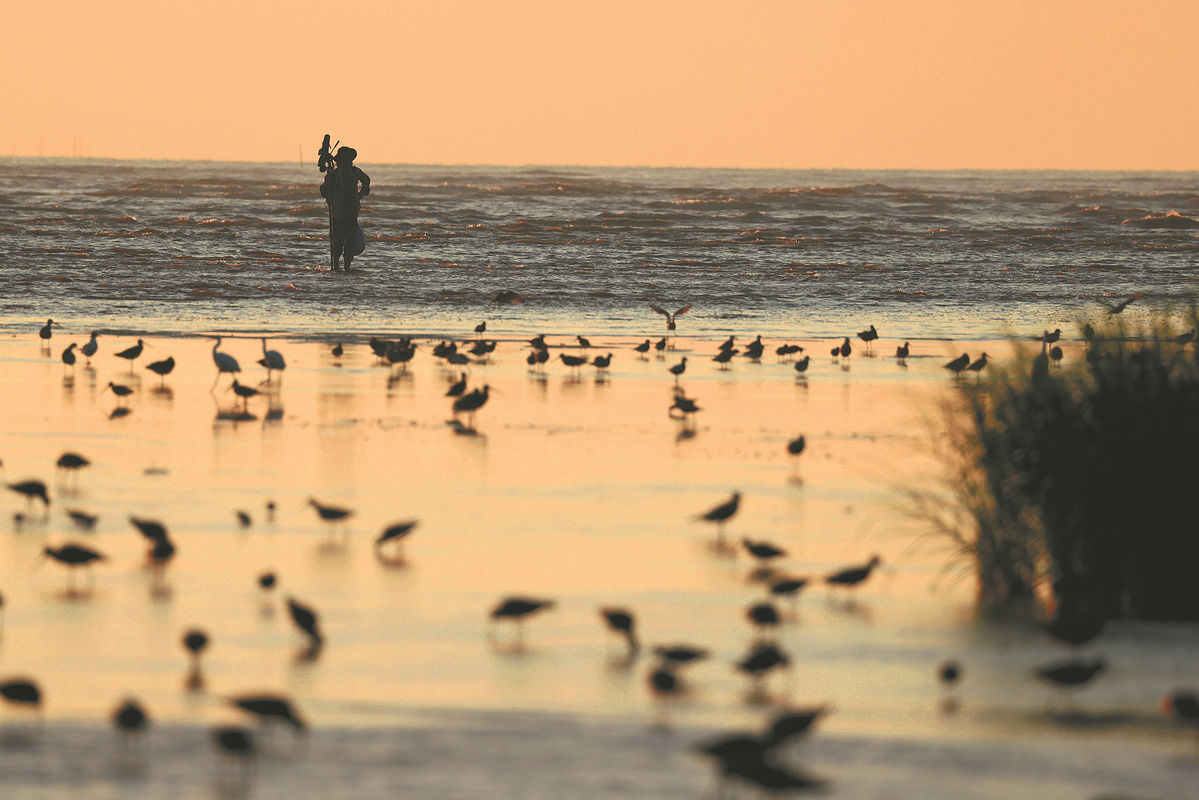Editor's Note: As protection of the planet's flora, fauna and resources becomes increasingly important, China Daily is publishing a series of stories to illustrate the country's commitment to safeguarding the natural world.

An aerial photo shows part of the Blue Bay project site. [Photo provided to China Daily]
A curved artificial embankment partly separates the mouth of the Linhong River from the vast expanse of the Yellow Sea in the coastal city of Lianyungang in Jiangsu province. Within the embankment lies patches of mudflats, a pond of shallow water and a dry shoreline marred by mounds of sand and rocks and overgrown with weeds.
The partly enclosed area, with a footprint equivalent to some 20 Palace Museums in Beijing, was once an intertidal mudflat. In the spring and autumn, it is a vital stopover site for thousands of water birds, particularly waders, as they pause to rest and forage during their migrations.
The site has become the focal point in an ongoing dispute between an environmental group and a developer that has persisted for nearly three years and shows little sign of resolution.
Judicial ruling
The site was approved as the construction area for the Jiangsu Lianyungang Blue Bay Remediation Project, with a budget exceeding 1.8 billion yuan ($250 million). The original plan was to create a waterfront recreation area for residents and tourists, forming a "seaside landscape of blue sea, blue sky and white sand", according to the developer.
However, construction at the site was recently halted by a court order after the Friends of Nature Environment Institute, a Beijing-based grassroots environmental nongovernmental organization, brought the project to court, contending that it was damaging the foraging grounds of migratory birds.
On Jan 4, the Nanjing Intermediate People's Court in Jiangsu ruled that the project poses a real risk of ecological damage and should cease construction until gaining further legal approval. Both the institute in charge of environmental assessment before the approval of the project and the construction company were held jointly responsible.
However, the court also stated that the current evidence does not conclusively prove the project's ecological damage or the risk of ecological destruction from the completed parts of the project.
The ruling marks a pivotal moment in the environmental public interest litigation that has rumbled on for three years so far. Some environmental law scholars said the ruling was a significant advancement in environmental justice, serving as a warning to all environmental assessment institutes, while a few conservationists consider the ruling to be only a small stop-gap to a project that they believe will ultimately gain approval.
Friends of Nature, also not satisfied that the ruling goes far enough, lodged an appeal with the court on Jan 18.
The project developer told Beijing News it also intends to appeal the ruling.

Asian dowitchers feed on the mudflat in Lianyungang during their autumn migration. LI YUNFENG/FOR CHINA DAILY
Legal action
Conservationist Li Jing is one of the initiators of the litigation.
The head of Spoon-billed Sandpiper in China, a nonprofit organization dedicated to the conservation of migratory water birds — especially the critically endangered bird that gave it its name — Li is familiar with the area because she and her team members regularly monitor migrating waterbirds along eastern China's coastline.
"The mudflat at the estuary is truly a valuable ecosystem," she said. It serves as foraging and resting grounds for many migratory waterbirds, including at least five species under first-class State protection, such as the Dalmatian pelican and relict gull, seven under second-class State protection and 15 globally threatened or near-threatened species, all coming here to forage during their migration, she added.
Among them is the Asian dowitcher, a medium-large wader with a long straight blunt-tipped dark bill, medium-length legs and long wings, a near-threatened species on the International Union for Conservation of Nature Red List.
Li and her colleagues discovered that the sandpiper has a high dependency on the mudflat. In the spring of 2019 and 2020, over 90 percent of its global population, exceeding 20,000 birds, visited the mudflat to forage."At the peak of migration, we counted more than 100,000 waders at the three estuaries in Lianyungang, including the Linhong Estuary," Li said.
Upon discovering the project signboard, Li was instantly alarmed. "My immediate concern was the extensive overlap between the project area and the bird habitat," she said.
The project reminded her of the Saemangeum reclamation project in South Korea, which resulted in irreversible losses for migratory shore birds."After the project, the population of the great knot (a shorebird species) in that area declined from nearly 90,000 to a little more than 10,000," Li said.
To prevent a similar tragedy, the SSC decided to take action. They collaborated with several conservation organizations, including the Paulson Institute, to report the situation to relevant authorities. At the end of 2019, the project was suspended for a period but resumed shortly after.
In March 2021, the Friends of Nature joined them, requesting the disclosure of environmental assessment documents. The response they received was that the Blue Bay project complied with the approval process and was legal and compliant.

Workers with Spoon-billed Sandpiper in China count birds at the Blue Bay project site in Lianyungang, Jiangsu, in 2020. HE TAO/FOR CHINA DAILY
Stopping construction
Public information indicates Blue Bay is an ecological restoration project.
It is part of the coastal environmental remediation project for the Lianyungang New City Center, as outlined in Lianyungang city's overall urban plan (2015-2030). Nearly 20 square kilometers of land in Lianyungang New City was reclaimed from the sea, causing the loss of its original natural shoreline's ecological function.
The city government proposed the construction of the "Blue Bay" in Lianyungang New City, with the project to be undertaken by Jinhaian Development and Construction Co.
The environmental assessment report shows that the project will effectively convert the ecological advantages of Lianyungang into economic benefits, bringing a series of environmental and ecological benefits, including significant improvement in seawater quality, providing excellent living space and breeding habitat for various wetland organisms and effectively curbing environmental degradation trends.
Due to its emphasis on ecological restoration, the project even received 300 million yuan in special funding from the central government in April 2019.
"The time was urgent and the situation was critical. Every day, the construction was damaging the foraging grounds of birds," said He Yini, head of the legal team for the Blue Bay case from Friends of Nature.
In April 2021, the NGO filed a public interest civil lawsuit with the Nanjing Intermediate People's Court, suing Jinhaian Development and Construction Co and the environmental assessment unit of Nanjing Normal University's Environmental Science and Technology Research Institute, requesting the stoppage of all construction activities, elimination of the ecological damage risk, ecological restoration of the damaged area and compensation.
After the court accepted the case, the NGO continued to submit complaint letters to relevant departments, and changes began to happen.
In November that year, the shoreline restoration project was suspended, followed by the suspension of the project's basement construction in January 2022.
From February to April 2022, the NGO submitted multiple letters of complaint to the Central Environmental Inspection Team and relevant authorities. A year later, the project was stopped by environmental protection inspection officials.

A worker with Spoon-billed Sandpiper in China prepares to conclude a bird survey on an intertidal mudflat in Lianyungang, Jiangsu province, in August. YANG ZIYOU/FOR CHINA DAILY
Restoration vs degradation
Due to the complexity of the case and its involvement in the specialized field of migratory bird protection, it has undergone three pre-trial meetings. One of the contentious issues in the case is whether the project is beneficial or harmful to the ecology.
Li revealed that the defendant has consistently emphasized that the project is an ecological restoration project. The court's judgment indicated that the practices within the project, such as planting vegetation at the shore, clearing invasive species and purchasing artificial fish ponds from fishermen, were intended to create habitats for waterbirds. Both the plaintiff and the defendant acknowledged during the trial that the number of bird species in the area in question had not decreased, and had even increased.
To Li and He, some damage had already been done.
Mud was excavated from a section of the mudflat to create a foundation for the shore in the construction of a sandy beach, He said. As a result, certain areas of the mudflat were turned into ponds and pits, unsuitable for shorebirds to forage in.
"More ducks and egrets came to use the site," conceded Li."But waders avoided the construction site."
He said: "When it comes to ecological restoration, most people naturally assume it is beneficial to the ecology, and that the plaintiff must prove that it has actually caused ecological damage. This is the biggest challenge we face."
Many experts have reacted to January's ruling and are eager to see how the appeals develop.
"This is a significant advancement in environmental tort and environmental public interest civil case adjudication, further implementing the provisions of the Environmental Protection Law," Wang Canfa, an environmental law scholar and a long-term observer of the case, told Beijing News.
He believes the ruling serves as a warning to all environmental assessment units. If they intentionally falsify information, omit evaluation factors, fabricate data or draw false evaluation conclusions, they may not only be subject to administrative penalties, but also be liable for damages together with the construction unit.
Another positive aspect of the first-instance judgment is that the court acknowledged the "real risk of ecological damage" posed by the Blue Bay project.
The case is a rare preventative public interest lawsuit against the reclamation of coastal wetlands in China, He said.
She explained that generally, lawsuits are based on consequences and damages, whereas preventative litigation is based on risks."In the environmental field, it is always based on risks. The destruction of mudflats and the extinction of species are irreversible," He said.
Why appeal?
The court also concluded that the existing evidence could not prove that the completed parts of the project had caused ecological damage or posed an ecological risk. Therefore, the court did not support the plaintiff's requests for eliminating risks, ecological restoration, compensation for losses and an apology.
Cai Zhiyang, an assistant professor of environmental science at Duke Kunshan University in Suzhou, Jiangsu, who has long been concerned about the population of Asian dowitchers in the waters of Lianyungang, told Beijing News that researchers had attached satellite trackers to several dowitchers of the population migrating in the area.
The research results showed that after the construction of the project began, there were almost no Asian dowitchers landing in the semi-circular construction area. "In other words, the area is no longer suitable for them to forage," Cai said.
This research result was also submitted as evidence to the court by the plaintiff. However, the judgment stated that the number of dowitchers providing flight trajectory maps was too small to prove a significant decrease in the number of birds in the area.
Friends of Nature believes that the judgment only supporting a temporary halt to construction does not completely eliminate the significant risk of the project damaging the natural foraging grounds of waterbirds.
"Despite the developer's assurance to halt the embankment construction and sandy beach development, we believe the completed part of the project has already caused ecological harm, and thus, the developer is obligated to restore and compensate for the damage," He said.
The legal battle continues.
Source: Chinadaily